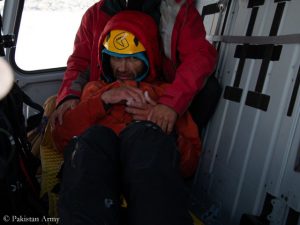Never without rope on a glacier
The longest rope team of the world. That is the goal of an action on Grossglockner, which, if it works, will find its place in the Guinness Book of Records. On Saturday at 2 p.m. mountain rescuers of Osttirol (Eastern Tyrol) will rope up as many climbers as possible on the Koednitzkees, a glacier below the highest peak of Austria. A notary is commissioned by the Guinness Book of Records to count the participants. Afterwards the Austrian artist Dieter Remler will make a performance, according to the motto: “As free as an eagle, with a person’s mind”. This is just one of several actions in Osttirol during this weekend which is dedicated to safety in the mountains . I contacted Peter Ladstaetter, district head of mountain rescue in Osttirol. He has organized the action on the Koednitzkees .
Peter, what is the message of forming the longest rope team of the world?
Our key message is: It must be a standard to take a rope before you enter or cross a glacier. Unfortunately many do not know that glacial ice is always moving and therefore also crevasses are “walking”. There are many falls which only end without serious consequences – in most cases even unhurt – because the mountaineers are roped up. A last year’s fall into a crevasse that ended with death gave us the idea to start a preventive campaign in order to raise awareness for alpine dangers. By the way, in my opinion not the mountain is dangerous, but the climber who doesn’t care about security standards.
Do you as rescuers notice that less climbers use ropes on glaciers with the consequence of avoidable accidents?
Not only mountain rescuers but all organizations with alpine competence have to take advantage of their opportunities (networks and know-how) to reach all climbers and hikers. 83 deaths year-to-date in the mountains of Tyrol (including Südtirol/South Tyrol) speak for themselves. The progress in technology and equipment in recent years allow us to go beyond our personal limits. Only if equipment, technology and knowledge harmonise, climbers can enjoy a wonderful and above all safe mountain adventure.
There are fatal accidents (as recently on the Sasso Lungo in Val Gardena), that might have ended less tragically if the climbers were not roped up. When should climbers rope up, when not?
Fatal accidents of whole rope teams are the absolute exception and usually have other reasons such as crossing a cornice or releasing a snow slab in case of fresh snow. We should not make the mistake of thinking that every accident is preventable. There will still be fatal mountain accidents, but we must do everything possible to inform climbers and hikers as well as possible and to raise awareness for alpine dangers. I am very pleased to see that an increasing number of people are attracted by nature to recharge their batteries. “People who love the mountains reflect the sunlight, those who remain in the valley, do not know their language.”









